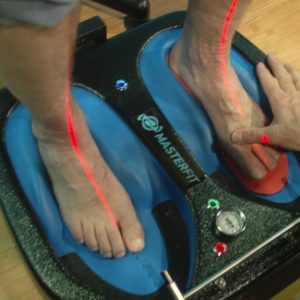Just because the ski boot is rigid and firm does not mean you don’t need in-the-boot-support.
The answer is you do because of the high level of force in each turn. Just normal skiing can place 2-3 times your body weight on the bottom of the foot and ski boot sole. That is enough to collapse the foot and increase pressure to the inside of the shin. Unfortunately, that is where the major blood vessels and nerves run.
The results for most people skiing without a properly constructed orthotic in their ski boot is foot pain, cold feet and less than optimal skiing.
The major difference for a ski boot orthotic is first rigidity. The boot doesn’t flex on the sole, so the orthotic needs to be rigid to take up those extra forces not encountered in walking. The second feature is to place the foot in a neutral position where it is powerful and can respond to quick movements.
On average, 75% of people should be using an orthotic or special insole. In skiing, the number jumps to 95% because of the unique nature of skiing!


